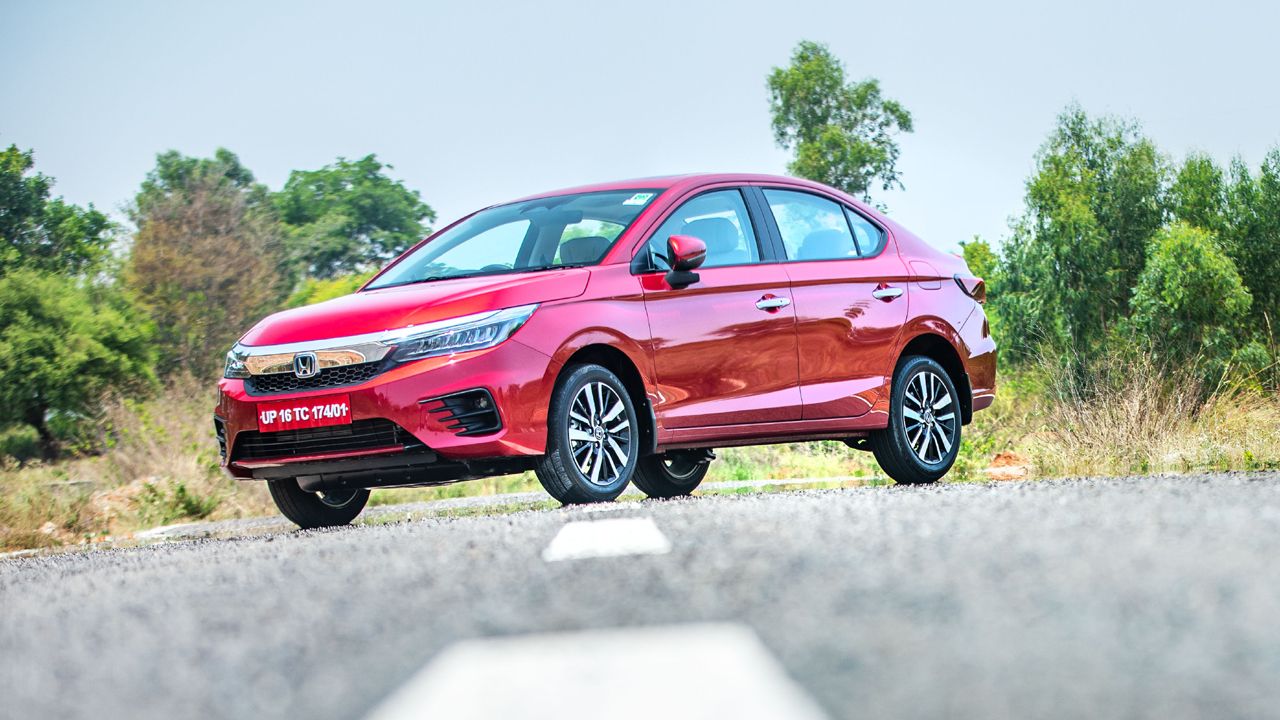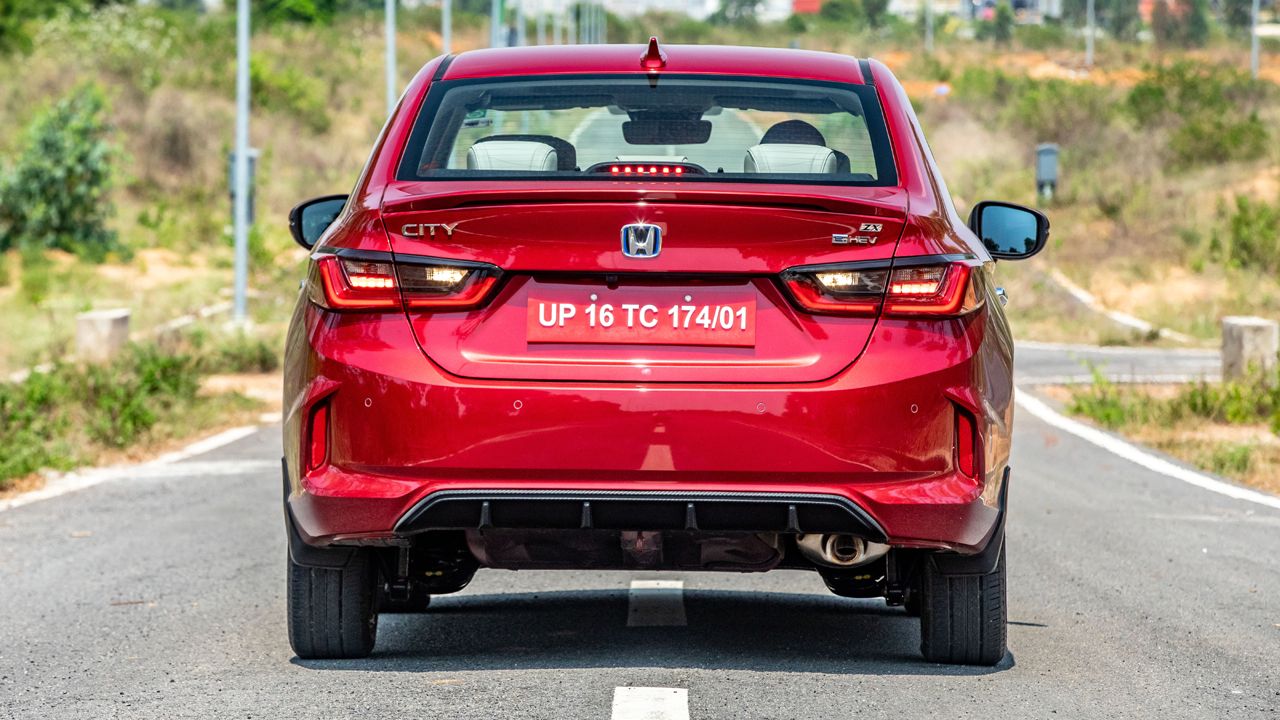
Honda City e:HEV Hybrid Review: First Drive
The Honda City e:HEV Hybrid oozes technology, promises class-leading fuel efficiency and looks stately. So, can it prove itself to be a strong hybrid contender in India? We drove it for a day to find out...

The Honda City e: HEV Hybrid oozes technology, promises class-leading fuel efficiency, and looks stately. So, can it prove itself to be a strong hybrid contender in India?
The Honda City has perhaps been one of the most revered nameplates in India, ever since the first generation of the car was launched in 1998. With its rock-solid reliability and understated yet effective styling, the City has won countless hearts in over two decades. But, to be honest, the current fifth-generation City has not yet enjoyed the same commercial success as some of its predecessors. In my opinion, the current-gen model has simply been a victim of faltering demand for sedans in general, thanks to a frenetic SUV boom and ever-growing competition.

So, what could Honda possibly do the provide the City with that much-needed boost? Fortunately, the answer, it seems, is simple – give the Indian market a taste of, perhaps, the most potent version of the sedan, the e:HEV Hybrid. I think this was an erudite move on Honda’s part. Not only did the Japanese marque get another solid opportunity to reiterate the capabilities of the City as a robust product but also the golden opportunity to remind the average Indian car buyer that hybrids are still a more rational and viable choice in terms of combating rising fuel prices and saving the planet. I’m saying this based on all the shortcomings of the public EV charging infrastructure in India.

After driving the City hybrid, I almost immediately knew that its key talking points would be the twin-motor e:HEV hybrid system, the mountain of tech it brings to the table, the subtle styling updates, which give it a refreshed overall design, and the Honda Sensing suite of active driver assistance features, which takes the City’s safety quotient up a few notches. Let’s delve deeper into each aspect.
A Visual Treat
Compared to the standard model, there are no major styling changes on the City e:HEV. That’s because the City already looks very smart and very balanced and champions the understated styling quotient. However, there are a few noteworthy changes and additions to the hybrid model, which give it a unique visual identity. For example, a new claw-type fog lamp garnish, a new ‘Solid Wing’ fascia featuring a honeycomb-pattern grille, a new blue H-mark logo, and nine-array LED headlamps together give the City e:HEV a fresh face. A new trunk lip spoiler, a carbon fibre-finish diffuser insert, and new side marker lamps in the LED taillights constitute the changes at the rear. The R16 alloy wheels get a new dual-tone black painted finish. And the interior benefits from the new two-tone ivory and black colour theme.

Tech Symphony: The Hybrid System
Honda refers to the City e:HEV as a ‘Strong Hybrid’, and for good reason. The powertrain consists of a 1.5-litre four-cylinder ‘Atkinson cycle’ i-VTEC DOHC petrol engine (it’s a different unit from the one that powers the standard City), a Lithium-ion battery pack, two AC synchronous motors – regeneration and traction – and a single-ratio electrically-coupled CVT, with an engine-linked clutch. In total, the hybrid powertrain develops an impressive 124.7bhp and 253Nm of torque. In comparison, the regular petrol City puts out 120bhp and 145Nm of torque.

The entire drive system operates via three auto-select drive modes – EV, Hybrid, and Engine. In EV mode, which is active when the car starts off, the wheels are powered purely by the battery and the traction motor. In Hybrid mode, the operation remains pretty much the same – only the engine comes to life as an electric generator, and it powers the regeneration motor, which, in turn, charges the Li-ion battery. In Hybrid mode, the engine does not directly power the wheels. The Engine mode kicks in when the car is running at a considerable speed under heavy throttle input. This time, the clutch forms a direct link between the engine and the wheels. So, while the wheels are powered directly by the engine, the battery and traction motor help provide a peak power boost whenever required. Being a proper hybrid, the City e:HEV also offers regenerative braking, which juices up the battery during deceleration.
On the Road
Drive the City e:HEV for a while, and you realise that it’s a machine that’s genuinely built to deliver excellent fuel economy. During my first drive, which was essentially a demonstration run for the Honda Sensing features, I drove the car at varying speeds, mostly on the highway, with four adult occupants, and the digital readout displayed a figure of a little over 19km/l, which is impressive, to say the least. Of course, if you pin the throttle to the floor on a straight stretch, the fuel economy will drop; however, it would give you the perfect opportunity to enjoy the City e:HEV’s oodles of torque and an engine that’s more than willing to be pushed to the limits. The only downside of doing this was the engine noise – it sounded gruff and strained when it really wasn't.

Also, because the City e:HEV gets rear disc brakes, which have also allowed engineers to add an electronic parking brake, and heavily retuned suspension, the car simply outperforms in terms of braking and overall ride quality. Under full load, sharper bumps and potholes can prove to be a little challenging, but under normal load, the City e:HEV simply glides over bad surfaces.
Interestingly, the single-speed e-CVT means that there’s no conventional multi-speed gearbox. However, to add a flair of sportiness to the overall driving feel, Honda engineers have added a faux gear change effect – while driving, the e-CVT mimics the gear-changing action of a standard multi-ratio CVT automatic, even though the car only has a single gear!

Honda Sensing
The City e:HEV also marks the debut of the Honda Sensing suite of active driver assistance systems in India. The suite comprises five key safety features: Collision Mitigation Braking System (CMBS), Road Departure Mitigation System (RDMS), Lane Keep Assist System (LKAS), Adaptive Cruise Control, and Auto High-Beam Assist. Honda claims that all these features have been extensively tuned to suit Indian road and traffic conditions, which, frankly speaking, doesn't seem to be an exaggeration, for the results were quite apparent during our test drive. The Honda Sensing features will win you over with their non-intrusive yet effective functioning, along with the clarity and ease of readability and understandability of all warning indications in the instrument cluster.

Verdict
If what you need is a reliable, good-looking, comfortable sedan that offers a surprisingly engaging drive experience and an unparalleled combination of performance and fuel efficiency, the City e:HEV makes a very strong case for itself. But, given that its standard kit consists of multiple feature additions (such as rear disc brakes) and a hybrid powertrain, which comes with numerous imported components, there's a significant bump in its sticker price, compared to the current variant line-up. At ₹19.49 lakh, the City e:HEV is about ₹4.5 lakh more expensive than the top-spec petrol ZX CVT variant (all figures are ex-showroom, Delhi). If you ask me, I think the premium is justified. But in a market like India, it all comes down to consumer sentiment. So, let's hope the City e:HEV finds a rational set of buyers!
Read more:
Honda unveils City e:HEV for India
Better late than never: Honda’s compact SUV is coming next year
Engine: 1,498cc / Inline-Four / Atkinson Cycle i-VTEC
Fuel: Petrol
Electric Motors: Dual AC Synchronous
Transmission: e-CVT / Front-Wheel Drive
Total Power: 124.7bhp
Total Torque: 253Nm
Fuel Efficiency: 26.5km/l (claimed)
Price: ₹19.49 Lakh (Ex-showroom, Delhi)
X-Factor: A fun-to-drive sedan with all the benefits of a hybrid and none of the drawbacks of an EV!
|
Pros |
Cons
|























Write your Comment on